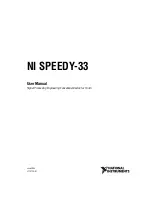SERIAL COMMUNICATION INTERFACE (SCI)
6 - 12
PORT C
MOTOROLA
SCI interrupts may be enabled by programming the SCI control registers before any of the
SCI pins are programmed as SCI functions. In this case, only one transmit interrupt can be
generated because the transmit data register is empty. The timer and timer interrupt will
operate as they do when one or more of the SCI pins is programmed as an SCI function.
6.3.1.1
Receive Data (RXD)
This input receives byte-oriented serial data and transfers the data to the SCI receive shift
register. Asynchronous input data is sampled on the positive edge of the receive clock (1
×
SCLK) if SCKP equals zero. See the
DSP56002 Technical Data Sheet
for detailed tim-
ing information. RXD may be programmed as a general-purpose I/O pin (PC0) when the
SCI RXD function is not being used.
6.3.1.2
Transmit Data (TXD)
This output transmits serial data from the SCI transmit shift register. Data changes on the
negative edge of the asynchronous transmit clock (SCLK) if SCKP equals zero. This out-
put is stable on the positive edge of the transmit clock. See the
DSP56002 Technical Data
Sheet
for detailed timing information. TXD may be programmed as a general-purpose I/O
pin (PC1) when the SCI TXD function is not being used.
6.3.1.3
SCI Serial Clock (SCLK)
This bidirectional pin provides an input or output clock from which the transmit and/or re-
ceive baud rate is derived in the asynchronous mode and from which data is transferred
in the synchronous mode. SCLK may be programmed as a general-purpose I/O pin (PC2)
when the SCI SCLK function is not being used. This pin may be programmed as PC2
when data is being transmitted on TXD since, in the asynchronous mode, the clock need
not be transmitted. There is no connection between programming the PC2 pin as SCLK
and data coming out the TXD pin because SCLK is independent of SCI data I/O.
6.3.2
SCI Programming Model
The resources available in the SCI are described before discussing specific examples of
how the SCI is used. The registers comprising the SCI are shown in Figure 6-8 and Figure
6-9. These registers are the SCI control register (SCR), SCI status register (SSR), SCI
clock control register (SCCR), SCI receive data registers (SRX), SCI transmit data regis-
ters (STX), and the SCI transmit data address register (STXA). The SCI programming
model can be viewed as three types of registers: 1) control – SCR and SCCR in Figure
6-8; 2) status – SSR in Figure 6-8; and 3) data transfer – SRX, STX, and STXA in Figure
6-9. The following paragraphs describe each bit in the programming model.
F
re
e
sc
a
le
S
e
m
ic
o
n
d
u
c
to
r,
I
Freescale Semiconductor, Inc.
For More Information On This Product,
Go to: www.freescale.com
n
c
.
..

















